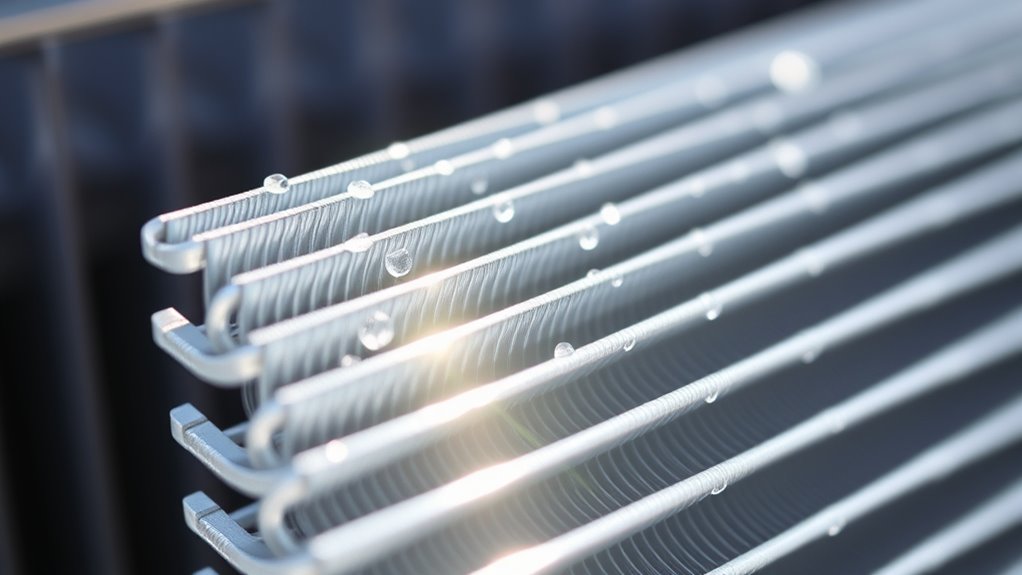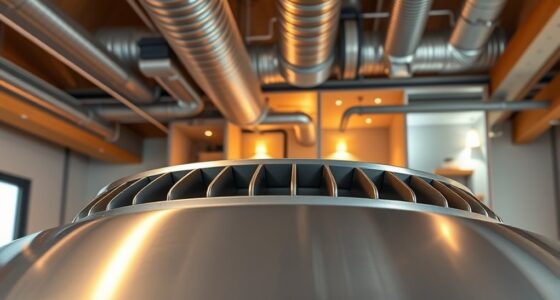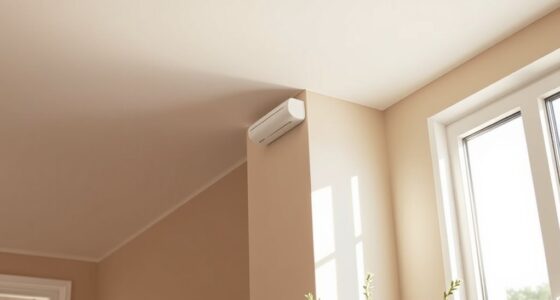To keep your portable AC breathing and working efficiently, it’s crucial to understand the condenser coil. Regularly inspect it for dirt, debris, and signs of corrosion, and clean it gently with a soft brush or vacuum. Using protective covers and scheduling routine maintenance can prevent clogs and damage. If you notice performance issues, calling a professional is advisable. Keep your system in top shape—learn more to make sure your AC stays cool and efficient.
Key Takeaways
- Regularly inspect and clean the condenser coil to prevent dirt buildup that hampers heat exchange.
- Look for signs of dirt, corrosion, or damage, and address issues promptly to maintain efficiency.
- Use gentle cleaning tools like soft brushes or vacuums; avoid harsh chemicals or high-pressure water.
- Protect the coil with covers during off-seasons to block debris, leaves, and pests from accumulating.
- Schedule professional maintenance if cooling performance declines or visible damage occurs to ensure proper system function.
What Is a Condenser Coil and How Does It Work?
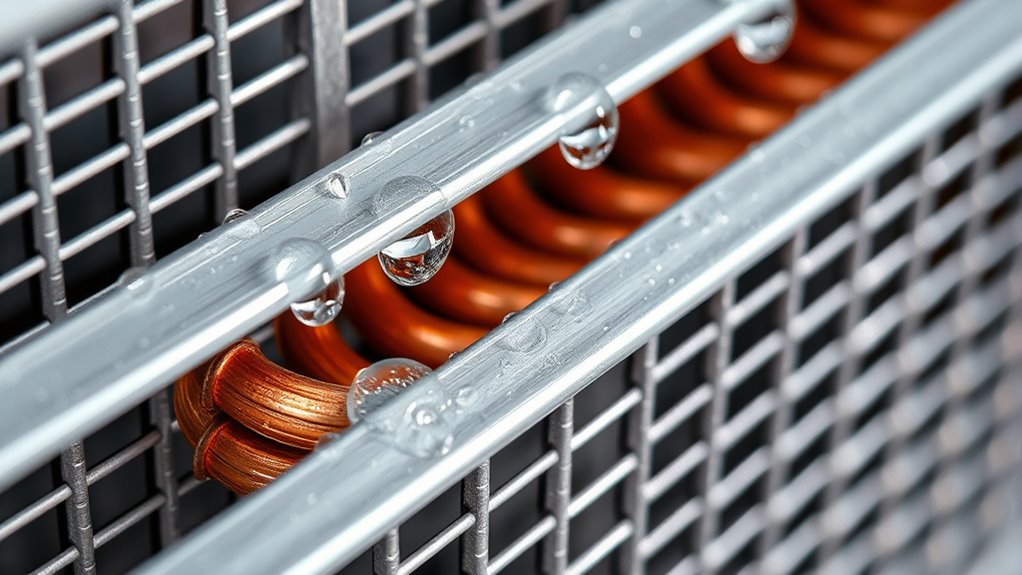
A condenser coil is a key component of your air conditioning or refrigeration system that helps remove heat. It works by allowing refrigerant to flow through it, releasing the heat absorbed from indoor spaces. As the refrigerant moves through the coil, it undergoes heat exchange—transferring heat from the refrigerant to the outside air. This process causes the refrigerant to condense from a high-pressure gas into a liquid, ready to cycle back inside for another round of cooling. The coil’s design maximizes surface area to facilitate efficient heat exchange, ensuring your system runs smoothly. Without a properly functioning condenser coil, heat removal would be inefficient, and your cooling system wouldn’t work effectively. That’s why maintaining this component is essential for maximum performance, especially considering the importance of high-quality components like the condenser coil for optimal operation.
Signs Your Condenser Coil Needs Attention

If your air conditioning system isn’t cooling as effectively as it used to, your condenser coil might be showing signs of trouble. One key indicator is refrigerant leakage, which can cause the coil to run inefficiently and reduce cooling power. You might notice the system struggles to reach set temperatures or runs constantly. Additionally, coil corrosion is a common sign of deterioration, often resulting in visible rust or discoloration on the coil surface. Corrosion weakens the coil’s structure, leading to leaks or failure. Regular maintenance can help prevent these issues from escalating. If you observe any of these signs, it’s crucial to address them promptly to prevent further damage and maintain peak performance. Routine inspections can help catch these issues early, saving you from costly repairs down the line.
Causes of Dirt and Clogs in the Coil
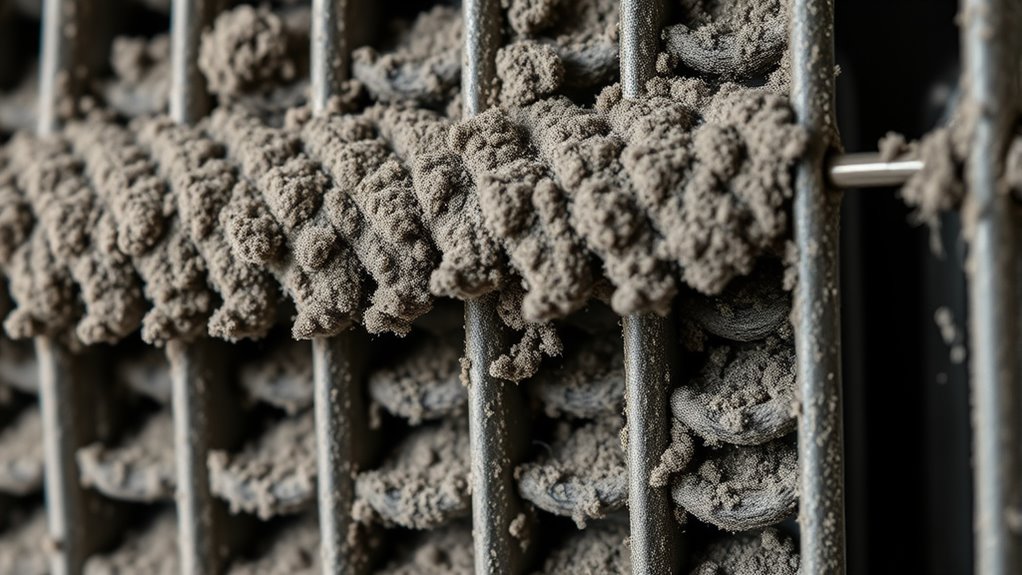
Dust, dirt, and debris can quickly build up on your condenser coil, reducing its efficiency. Outdoor elements like pollen, leaves, and insects also contribute to clogs over time. Understanding these causes helps you prevent blockages and keep your system running smoothly. Regular cleaning and maintenance can further improve system efficiency and prolong the lifespan of your portable AC.
Dust and Debris Accumulation
Over time, dirt and debris naturally settle on the condenser coil, especially if your outdoor unit faces wind, foliage, or nearby construction. This buildup can block airflow, reducing the coil’s efficiency. Poor air filter maintenance inside your portable AC can also allow dust to circulate and settle on the coil. Additionally, low refrigerant levels cause the system to work harder, increasing heat and attracting more debris. When dust accumulates, it hampers heat transfer, forcing your AC to strain more and consume extra energy. Regular cleaning of the coil helps prevent clogs, while maintaining proper refrigerant levels ensures ideal operation. Keep a close eye on both dust buildup and refrigerant to keep your portable AC running smoothly and efficiently. Dog names can also serve as a fun way to personalize and motivate maintenance routines.
Outdoor Environment Factors
Outdoor environment factors play a significant role in causing dirt and clogs on your condenser coil. When your unit is exposed to the outdoors, dust accumulation becomes a common issue. Wind carries dirt, leaves, pollen, and other debris that settle on the coil’s surface. Over time, these particles build up, restricting airflow and reducing efficiency. Humid conditions can also promote mold growth, further clogging the coil’s fins. Nearby trees and plants shed leaves and sap, which can stick to the coil and trap dirt. Frequent exposure to outdoor elements accelerates dirt accumulation, making regular cleaning essential. Understanding these factors helps you take proactive steps, like positioning the unit away from heavy foliage and scheduling routine maintenance to keep your portable AC running smoothly.
How to Inspect Your Portable AC’s Condenser Coil
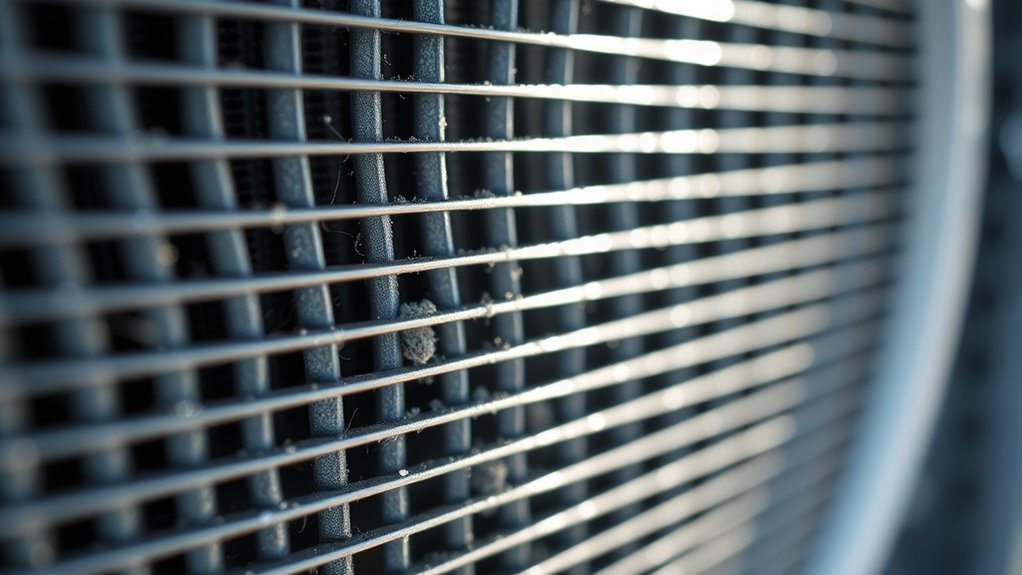
To guarantee your portable AC runs efficiently, regularly inspecting the condenser coil is essential. Start by turning off and unplugging your unit for safety. Locate the coil, usually at the back or side, and visually check for dirt, debris, or obstructions. Look for signs of dust buildup, leaves, or pet hair that could cause airflow restriction. Touch the coil gently to see if it feels clogged or covered in grime. A dirty coil hampers airflow, reducing cooling efficiency and straining the compressor. If you notice any blockages or dirt, it’s time to take further action. Regular inspections help you catch issues early, ensuring your portable AC maintains ideal performance and energy efficiency. Embracing regular maintenance and understanding your unit’s components can enhance its longevity and efficiency.
Step-by-Step Guide to Cleaning the Coil
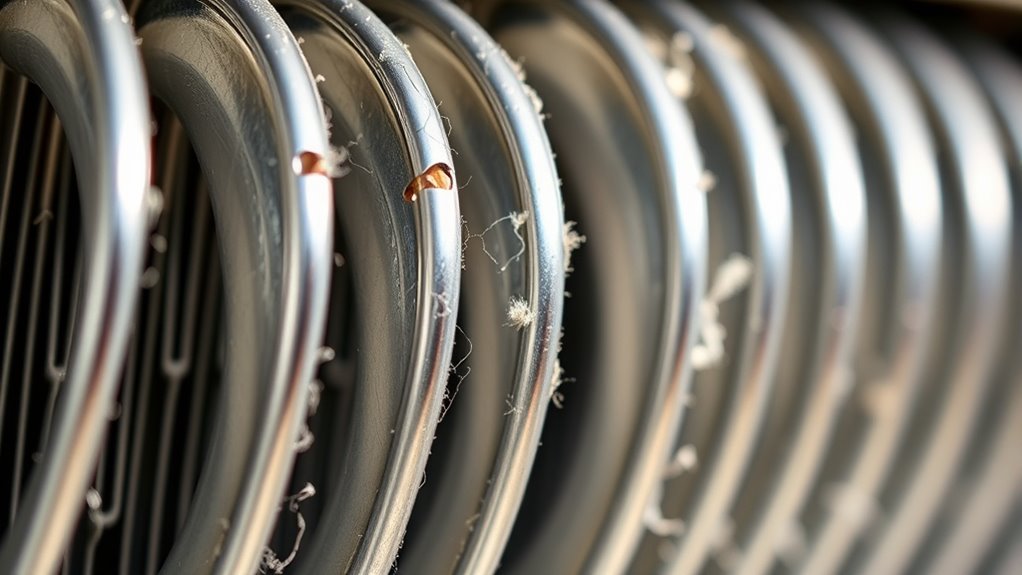
Cleaning your portable AC’s condenser coil is straightforward when you follow a few simple steps. First, turn off the unit and unplug it for safety. Remove the outer panels to access the coil. Use a soft brush or vacuum to gently remove dust and debris. Next, spray the coil with a coil cleaning solution or a mixture of water and mild detergent. Let it sit for a few minutes, then rinse with water. For effective maintenance, establish a regular maintenance schedule—ideally every 1-3 months, depending on usage. Keep track of cleaning dates to prevent buildup. Regular cleaning of your condenser coil enhances cooling efficiency and prolongs the lifespan of your portable AC. Here’s a quick overview:
| Step | Action | Tips |
|---|---|---|
| Turn off & unplug | Safety first | Never clean while plugged in |
| Remove panels | Access the coil | Keep screws organized |
| Clean & rinse | Use gentle tools & water | Avoid damaging fins |
| Dry & reassemble | Ensure dry before restarting | Prevent mold formation |
Preventative Tips to Keep Your Coil Clean

To keep your condenser coil clean, make sure to regularly clear away any debris like leaves and dirt. Using protective covers can also prevent dust buildup and damage during off-seasons. These simple steps help maintain efficiency and extend the life of your coil. Additionally, performing seasonal cleaning and maintenance checks can further improve your unit’s performance.
Regularly Clear Debris
Regularly clearing debris from your condenser coil is essential for peak performance. Dirt, leaves, and dust can cause airflow restriction, making your unit work harder and reducing efficiency. Over time, debris buildup can also lead to coil corrosion, shortening its lifespan. To prevent these issues, inspect your coil frequently and remove any obstructions. Use a soft brush or vacuum to gently clear away debris without damaging the fins. Maintaining a clean coil ensures proper airflow and ideal heat exchange, keeping your portable AC running smoothly. Here’s a quick guide:
| Debris Type | Action Needed |
|---|---|
| Leaves & Dust | Remove with brush or vacuum |
| Dirt & Grime | Gently clean with water or coil cleaner |
| Pollen & Debris | Clear regularly during high pollen season |
| Corrosion Signs | Address early to prevent damage |
Additionally, understanding the self-watering plant pots system can help you maintain healthier indoor environments, as they promote consistent moisture for your plants, reducing the need for frequent watering.
Use Protective Covers
Using protective covers over your condenser coil adds an effective layer of defense against debris buildup and environmental damage. These covers help prevent leaves, dirt, and pests from settling on the coil, reducing the risk of clogs and inefficient operation. Protective covers also shield your coil from harsh weather conditions like hail or heavy rain, which can cause damage over time. Proper coil protection extends the lifespan of your portable AC and maintains peak performance. When choosing a cover, ensure it fits well and allows for airflow to prevent moisture buildup. Regularly inspect and clean the protective cover to keep it effective. Additionally, understanding the importance of lifestyle factors can help you develop a routine for maintaining your AC, such as scheduling regular cleaning and inspections. Investing in coil protection is a simple, proactive step that keeps your condenser coil clean and your AC running smoothly.
When to Call a Professional for Coil Maintenance
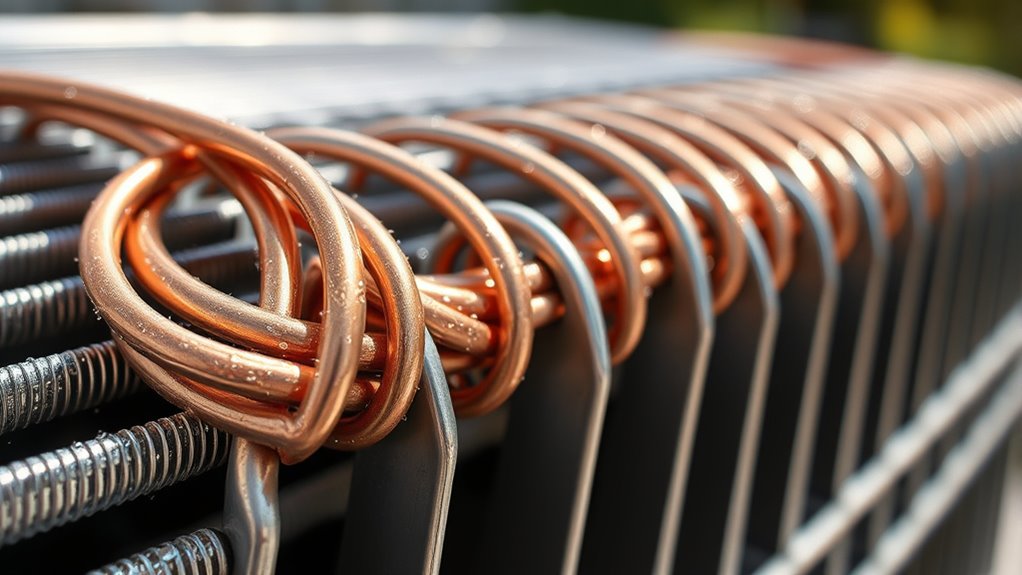
Knowing when to call a professional for coil maintenance can save you time and prevent costly damage. If your portable AC isn’t cooling effectively despite regular cleaning, it’s time to seek expert help. Signs include frequent cycling, unusual noises, or visible damage to the coil. If you notice a significant reduction in airflow or increased energy bills, a professional can diagnose underlying issues that affect HVAC energy efficiency. Additionally, if you’re unsure about handling delicate components, it’s best to avoid risking further damage. Just as indoor plant care requires the right knowledge and tools, coil maintenance benefits from expert attention to ensure peak performance. Proper airflow is essential for efficient cooling, and a clean condenser coil can greatly improve your unit’s effectiveness. Calling a professional ensures thorough cleaning and proper repairs, keeping your portable AC breathing easily and running efficiently.
Common Mistakes to Avoid During Cleaning
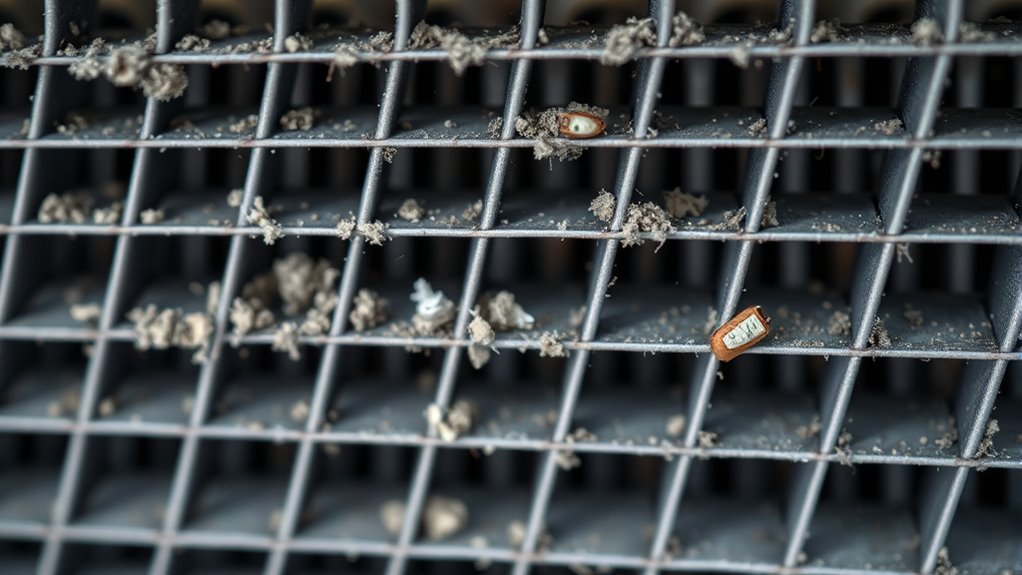
Avoiding common mistakes during coil cleaning can prevent damage and guarantee your air conditioner operates efficiently. One mistake to avoid is using harsh cleaning tools like metal brushes, which can damage the delicate fins. Instead, stick to gentle DIY tips, such as using a soft brush or a fin comb. Don’t spray water directly onto the coil with high pressure; this can bend fins or cause electrical issues. Be careful with cleaning solutions—avoid using overly aggressive chemicals that may corrode the coil. Also, rushing through the process can lead to missed spots or improper cleaning. Take your time, and ensure you thoroughly clean all accessible areas. Using the right tools and techniques helps keep the coil in top shape without risking damage or reducing efficiency. Remember, proper maintenance can also enhance the longevity of your portable AC.
The Benefits of Regular Coil Maintenance
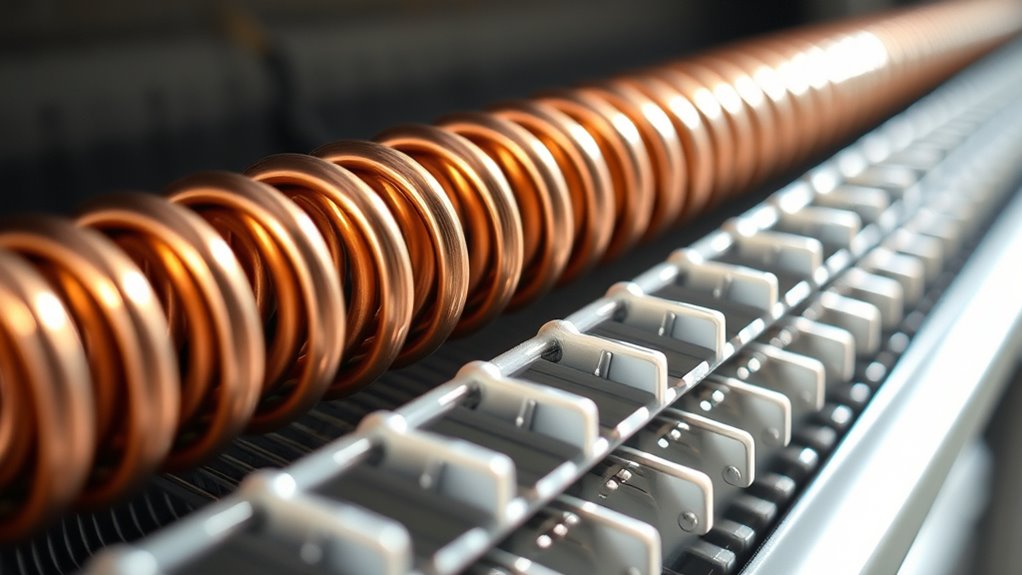
Regular coil maintenance guarantees your air conditioner runs efficiently and lasts longer. When you keep your condenser coil clean, your unit operates at peak energy efficiency, reducing electricity consumption. This means you’ll notice lower energy bills and fewer repairs over time. Regular maintenance prevents dirt, dust, and debris from clogging the coil, which can cause your system to work harder and wear out faster. By investing a little time into routine cleaning, you save money through improved performance and fewer costly repairs. Plus, a well-maintained coil ensures your portable AC cools effectively, maintaining comfort in your space. Overall, consistent coil upkeep not only enhances your unit’s lifespan but also delivers significant cost savings and energy efficiency benefits. Incorporating environmental considerations into your maintenance routine helps protect local ecosystems and supports sustainable living.
Frequently Asked Questions
Can a Dirty Condenser Coil Affect My Portable Ac’s Energy Efficiency?
A dirty condenser coil definitely affects your portable AC’s energy efficiency. When airflow obstruction occurs due to dirt or debris, the coil struggles to release heat, making your unit work harder. Plus, coil corrosion can further impair heat transfer. Both issues force your AC to consume more energy, reducing its efficiency and increasing your power bills. Regularly cleaning and inspecting the coil helps keep your portable AC running smoothly and efficiently.
How Often Should I Schedule Professional Maintenance for My Condenser Coil?
Is your portable AC running smoothly, or is it begging for help? You should schedule professional maintenance for your condenser coil at least once a year, or more often if you notice reduced efficiency. During the maintenance schedule, ask for a coil inspection to catch issues early. Regular upkeep guarantees your unit breathes easily, runs efficiently, and keeps you cool all season long. Don’t wait—prolonged neglect costs more in the long run.
Are There Specific Cleaning Products Recommended for Condenser Coils?
You should use gentle coil cleaning solutions specifically designed for condenser coils. Avoid harsh chemicals and opt for DIY coil cleaners or commercial coil cleaners that are safe for your unit. Follow the manufacturer’s instructions carefully, applying the cleaner and gently rinsing to avoid damage. Regular use of these cleaning products helps maintain peak airflow, improves efficiency, and prolongs your portable AC’s lifespan.
What Are the Risks of Neglecting Coil Cleaning in Hot Climates?
Ignoring coil cleaning in hot climates is like letting a silent predator lurk; coil corrosion worsens, causing the system to strain and falter. This negligence increases the risk of refrigerant leaks, which can silently sap cooling power and inflate energy bills. Without proper maintenance, your portable AC becomes a fragile shell, vulnerable to overheating and costly repairs, leaving you in the heat’s relentless grip.
Can a Condenser Coil Be Replaced Instead of Cleaned?
Yes, you can replace a condenser coil instead of cleaning it. When considering coil replacement, you’ll need to follow specific procedures, including safely disconnecting the unit, removing the faulty coil, and installing a new one that matches your portable AC’s specifications. While replacement can be effective, regular cleaning is often a simpler, more cost-effective way to maintain efficiency. However, if damage is extensive, replacement might be your best option.
Conclusion
Keeping your portable AC’s condenser coil clean is like giving it a gust of fresh air—you’ll notice better cooling and efficiency. Regular inspections and gentle cleaning help prevent costly repairs and extend your unit’s lifespan. Don’t wait until it’s too late; stay proactive and treat your AC coil like a best friend that keeps you cool on hot days. With a little effort, your portable AC will keep breathing easy and working at its best.
